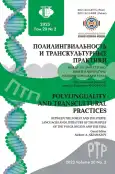Semantics of Verbs of Rotation in the Khanty language
- 作者: Solovar V.N.1
-
隶属关系:
- Ob-Ugric Institute of Applied Research and Development
- 期: 卷 20, 编号 2 (2023): BETWEEN THE FOREST AND THE STEPPE: LANGUAGES AND LITERATURE OF THE PEOPLES OF THE VOLGA REGION AND THE URAL
- 页面: 271-282
- 栏目: Language in System
- URL: https://journal-vniispk.ru/2618-897X/article/view/326698
- DOI: https://doi.org/10.22363/2618-897X-2023-20-2-271-282
- EDN: https://elibrary.ru/JSXVCT
- ID: 326698
如何引用文章
全文:
详细
The article is devoted to the identification of the national specifics of the representation of rotational movement in the Khanty linguoculture, the analysis of the semantics of verbs of rotation, the possibility of their lexical compatibility on the material of the Western dialects of the Khanty language (Kazym, Shuryshkar, Uralic) and one of the eastern (Surgut) by the types of situations described by them. The purpose of our study is to identify the parameters relevant to the lexical rotation zone. The article uses the method of corpus research: a sample of examples with verbs of rotation is analyzed and the boundaries of their compatibility are determined. The method of field research is used. There is a difference between movement along a trajectory close to an ideal circle (rotation in a circle) and movement along a chaotic trajectory, i.e. rotation of a set of homogeneous objects / gaseous particles (deer, snow vortex, smoke). In this case, the second type of rotation is marked. The subject performs multiple or single rotations around its axis or causates a rotational movement. The key parameter for distinguishing verbs of rotation and skating is animateness. Verbs of rotation around a landmark reflect the way of movement. Verbs of rolling and rotation do not reflect the environment of movement, but may reflect the direction of movement, which is regulated by the special compatibility of the subject and the predicate, or the word-formation capabilities of the predicate. The rolling zone reflects rotation in contact with the plane during translational motion and multidirectional rotation (about natural phenomena and about the movement of deer). The selected parameters and values are not lexicalized into separate verbs, but are combined inside lexemes. One lexeme describes situations of rotation in the same plane with and above the landmark, however, skating on the surface and rotation around the landmark is marked in dialects by separate lexemes.
作者简介
Valentina Solovar
Ob-Ugric Institute of Applied Research and Development
编辑信件的主要联系方式.
Email: solovarv@mail.ru
ORCID iD: 0000-0003-4894-0117
Chief Research, Doctor of Philology
Mira str., 14A, Khanty-Mansiysk Autonomous District - Yugra, Khanty-Mansiysk, 628011, Russian Federation参考
- Valgamova, N.B. et al. 2011. Dialectological dictionary of the Khanty language (Shuryshkar and Ural dialects). Ekaterinburg: Basko publ. Print. (In Russ.).
- Lelkhova, F.M. 2012. Dictionary of verbs of the Khanty language (Shuryshkar dialect). Khanty-Mansiysk: OAO Izdatelskiy dom “Novosti Yugry” publ. Print. (In Russ.).
- NOSS — Novyy obyasnitelnyy slovar sinonimov russkogo yazyka. 2004. Edited by Yu.D. Apresyan. Moscow; Vena: Yazyki slavyanskoy kultury publ. Print. (In Russ.).
- Rakhilina, E.V., and I.A. Prokofyeva. 2004. “Related languages as an object of lexical typology: Russian and Polish verbs of rotation”. Voprosy yazykoznaniya 1: 60–78. Print. (In Russ.).
- Ibragimova, V.L. 1982. “Semanticheskiye klassy glagolov kolebatelnogo i vrashchatelnogo dvizheniya v russkom yazyke”. In Issledovaniya po semantike. Ufa: Izd-vo Bashkir. Gos. unta publ. Pp. 66–74. Print. (In Russ.).
- Kruglyakova, V.A., Rakhilina E.V. 2010. “Verbs of rotation: lexical tipology”. Dialog 1: 240–247. Print. (In Russ.).
- Behaghel, O. 1924. Deutsche Syntax: Eine geschichtliche Darstellung. Band 2: Die Wortklassen und Wordformen. B. Adverbium. C. Verbium. Heidelberg. Winter. Print.
补充文件









